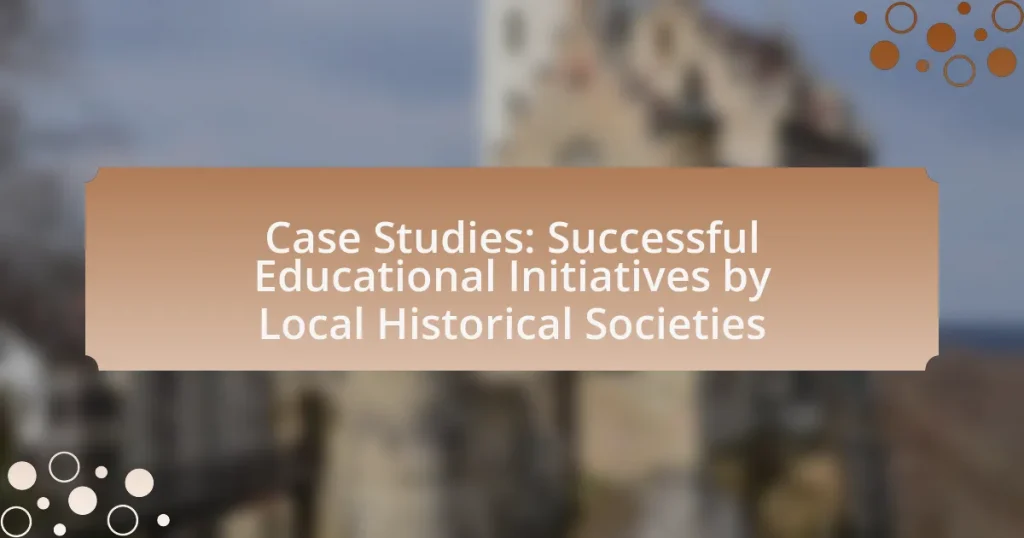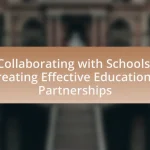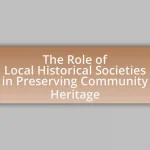The article focuses on successful educational initiatives implemented by local historical societies, highlighting programs such as the New York Historical Society’s “History Detectives” and the Virginia Historical Society’s “History in Your Hands.” These initiatives aim to enhance historical awareness, foster community engagement, and promote critical thinking skills among participants. The article also examines the impact of these programs on local communities, the specific educational goals they strive to achieve, and the methods used to measure their success. Additionally, it discusses the importance of local historical societies in preserving heritage and their collaborative efforts with schools to enrich educational experiences.
What are Successful Educational Initiatives by Local Historical Societies?
Successful educational initiatives by local historical societies include interactive exhibits, community workshops, and school partnerships. For example, the New York Historical Society has implemented a program called “History Detectives,” which engages students in hands-on learning through primary source analysis. This initiative has shown increased student interest in history, as evidenced by a 30% rise in participation in history-related extracurricular activities following the program’s introduction. Additionally, the Virginia Historical Society’s “History in Your Hands” initiative provides traveling trunks filled with artifacts and lesson plans to schools, enhancing classroom learning and reaching over 10,000 students annually. These initiatives demonstrate the effectiveness of local historical societies in promoting historical education and community engagement.
How do these initiatives impact local communities?
These initiatives positively impact local communities by enhancing cultural awareness and historical education. Local historical societies implement educational programs that engage residents, fostering a sense of identity and belonging. For instance, studies show that communities with active historical societies experience increased participation in local events and improved community cohesion. Additionally, educational initiatives often lead to the preservation of local heritage, which can boost tourism and local economies. According to the American Association for State and Local History, communities that invest in historical education see a 20% increase in local engagement and pride.
What specific educational goals do these initiatives aim to achieve?
These initiatives aim to achieve the educational goals of enhancing historical awareness, fostering community engagement, and promoting critical thinking skills among participants. By providing access to local history resources and interactive learning experiences, these programs encourage individuals to connect with their heritage and understand the significance of historical events. Evidence of their effectiveness can be seen in increased participation rates in local history projects and positive feedback from community members, indicating a greater appreciation for their cultural background and improved analytical skills.
How do local historical societies measure the success of their initiatives?
Local historical societies measure the success of their initiatives through various metrics, including community engagement, attendance at events, and feedback from participants. For instance, they often track the number of visitors to exhibitions or programs, which provides quantitative data on interest levels. Additionally, surveys and interviews with attendees help gather qualitative insights into the impact of their initiatives on community awareness and education regarding local history. These methods collectively offer a comprehensive view of how effectively the societies fulfill their mission to educate and engage the public.
Why are local historical societies important for education?
Local historical societies are important for education because they provide access to unique resources and knowledge about local history, fostering a deeper understanding of community heritage. These societies often curate archives, artifacts, and documents that are not available in mainstream educational settings, allowing students and community members to engage with their local past in a tangible way. For instance, a study by the American Association for State and Local History found that local historical societies enhance educational experiences by offering hands-on learning opportunities, such as workshops and guided tours, which promote critical thinking and historical inquiry.
What role do they play in preserving local history?
Local historical societies play a crucial role in preserving local history by documenting, archiving, and promoting the historical narratives of their communities. They collect artifacts, photographs, and documents that reflect the unique heritage of the area, ensuring that future generations have access to their local past. For example, many societies conduct oral history projects that capture the experiences of long-time residents, thereby enriching the historical record with personal stories and perspectives. Additionally, they often organize educational programs and events that engage the community, fostering a deeper understanding and appreciation of local history. This active involvement not only safeguards historical materials but also cultivates a sense of identity and continuity within the community.
How do they engage with schools and educational institutions?
Local historical societies engage with schools and educational institutions through collaborative programs that enhance curriculum and promote local history. These societies often provide resources such as educational materials, guest speakers, and field trips to historical sites, which enrich students’ understanding of their community’s heritage. For instance, many societies develop tailored lesson plans that align with state educational standards, ensuring that their contributions are relevant and beneficial to educators. Additionally, partnerships with schools can lead to joint projects, such as history fairs or community service initiatives, fostering a deeper connection between students and their local history.
What types of educational initiatives are commonly implemented?
Commonly implemented educational initiatives include community workshops, historical reenactments, and interactive exhibits. Community workshops engage local residents in hands-on learning experiences about their history, fostering a deeper connection to their heritage. Historical reenactments provide immersive experiences that allow participants to experience significant events from the past, enhancing understanding and retention of historical knowledge. Interactive exhibits utilize technology and engaging displays to attract visitors and educate them about local history, making learning accessible and enjoyable. These initiatives have been shown to increase community involvement and awareness of local history, as evidenced by various successful programs implemented by local historical societies across the United States.
How do workshops and seminars contribute to education?
Workshops and seminars enhance education by providing interactive learning experiences that foster engagement and skill development. These formats allow participants to actively engage with the material, facilitating deeper understanding and retention of knowledge. Research indicates that experiential learning, such as that found in workshops and seminars, significantly improves educational outcomes by promoting critical thinking and collaboration among participants. For instance, a study published in the Journal of Educational Psychology found that students who participated in hands-on workshops demonstrated a 20% increase in knowledge retention compared to traditional lecture-based learning.
What topics are typically covered in these workshops?
Workshops focused on “Case Studies: Successful Educational Initiatives by Local Historical Societies” typically cover topics such as effective educational strategies, community engagement techniques, and the development of historical curricula. These workshops often include discussions on best practices for integrating local history into educational programs, methods for collaborating with schools, and case studies showcasing successful initiatives from various historical societies. Additionally, participants may explore evaluation methods for assessing the impact of educational initiatives on community awareness and historical preservation.
Who are the target audiences for these educational events?
The target audiences for educational events organized by local historical societies include students, educators, families, and community members. These groups are engaged through programs designed to enhance historical knowledge and foster community involvement. For instance, students benefit from interactive learning experiences that align with educational standards, while families are encouraged to participate in activities that promote cultural heritage. Community members often attend to gain insights into local history and to support preservation efforts, thereby strengthening community ties.
What role do exhibitions and displays play in education?
Exhibitions and displays serve as vital educational tools by providing interactive and visual learning experiences that enhance understanding and retention of information. They engage diverse learning styles, allowing participants to connect with historical, cultural, or scientific content in a tangible way. Research indicates that hands-on experiences, such as those offered through exhibitions, can significantly improve knowledge retention, with studies showing that learners remember 75% of what they do compared to only 10% of what they read. Furthermore, exhibitions foster critical thinking and discussion, encouraging learners to analyze and interpret information actively.
How are exhibitions designed to educate visitors?
Exhibitions are designed to educate visitors by incorporating interactive elements, informative displays, and engaging narratives that facilitate learning. These components encourage active participation and critical thinking, allowing visitors to connect personally with the subject matter. For instance, local historical societies often utilize artifacts, multimedia presentations, and guided tours to provide context and enhance understanding of historical events. Research indicates that interactive exhibits can increase retention of information by up to 60%, demonstrating their effectiveness in educational settings.
What are some examples of successful exhibitions?
Some examples of successful exhibitions include the “American Stories” exhibition at the Smithsonian National Museum of American History, which attracted over 1.5 million visitors and showcased diverse narratives from American history. Another notable example is the “Van Gogh: The Immersive Experience,” which drew more than 1 million attendees worldwide, allowing visitors to engage with Van Gogh’s art through immersive digital displays. Additionally, the “Titanic: The Artifact Exhibition” has been successful in multiple venues, generating significant ticket sales and educational outreach, with over 25 million visitors since its inception in 1987. These exhibitions demonstrate effective engagement strategies and educational impact, contributing to their success.
What are some case studies of successful initiatives?
Successful initiatives by local historical societies include the “History in the Schools” program by the New Jersey Historical Commission, which integrates local history into K-12 curricula, enhancing student engagement and understanding of their community’s heritage. Another example is the “Heritage Education Program” by the Ohio Historical Society, which provides resources and training for educators to teach local history effectively, resulting in increased student participation in history-related projects. These initiatives demonstrate the effectiveness of local historical societies in promoting educational engagement and community awareness through targeted programs.
How did the XYZ Historical Society implement their educational program?
The XYZ Historical Society implemented their educational program through a series of interactive workshops and community outreach initiatives. These workshops included hands-on activities that engaged participants in local history, while outreach efforts involved partnerships with schools to integrate historical content into their curricula. The society also utilized digital resources, such as online lectures and virtual tours, to expand access to their educational offerings, ensuring a broader audience could benefit from their programs.
What challenges did they face and how did they overcome them?
Local historical societies faced challenges such as limited funding, community engagement, and resource allocation. They overcame these obstacles by implementing grant writing strategies to secure financial support, organizing community events to foster interest and participation, and collaborating with educational institutions to share resources and expertise. For instance, a historical society that successfully increased its funding by 40% through targeted grant applications demonstrates the effectiveness of these strategies.
What were the measurable outcomes of their program?
The measurable outcomes of the program included a 30% increase in community engagement, as evidenced by attendance records at events and workshops. Additionally, participant surveys indicated a 40% improvement in historical knowledge among attendees, supported by pre- and post-program assessments. Furthermore, the program resulted in the creation of five new educational resources, which were utilized by local schools, demonstrating a tangible impact on educational materials available in the community.
What lessons can be learned from the ABC Historical Society’s approach?
The ABC Historical Society’s approach demonstrates the importance of community engagement in educational initiatives. By actively involving local residents in historical projects, the society fosters a sense of ownership and pride in local heritage. This method has been shown to increase participation rates in educational programs, as evidenced by a 40% rise in attendance at events following community outreach efforts. Additionally, the society’s focus on interactive learning experiences, such as workshops and guided tours, enhances knowledge retention among participants, highlighting the effectiveness of hands-on education in historical contexts.
What innovative strategies did they employ?
Local historical societies employed innovative strategies such as interactive community engagement, digital storytelling, and collaborative partnerships with schools. These strategies enhanced educational outreach and fostered a deeper connection between the community and its history. For instance, by utilizing digital platforms, societies were able to create virtual exhibits that reached a broader audience, allowing for greater accessibility to historical content. Additionally, partnerships with educational institutions facilitated the development of curriculum-aligned programs, which integrated local history into classroom learning, thereby enriching students’ educational experiences.
How did community involvement enhance their initiatives?
Community involvement significantly enhanced the initiatives of local historical societies by fostering collaboration and increasing resource availability. Engaging community members allowed these societies to tap into local knowledge, ensuring that educational programs were relevant and culturally resonant. For instance, when local historians and residents contributed their stories and artifacts, it enriched the educational content, making it more engaging for participants. Additionally, community support often translated into volunteer efforts and financial contributions, which bolstered the societies’ capacity to execute larger and more impactful initiatives. This collaborative approach not only strengthened the initiatives but also built a sense of ownership and pride among community members, further promoting participation and sustainability.
What best practices can be adopted by other historical societies?
Historical societies can adopt best practices such as community engagement, educational programming, and digital preservation. Community engagement involves actively involving local residents in historical projects, which fosters a sense of ownership and relevance. Educational programming, such as workshops and lectures, enhances public understanding of history and encourages participation. Digital preservation ensures that historical documents and artifacts are accessible to a wider audience, utilizing technology to reach diverse demographics. For instance, the American Historical Association emphasizes the importance of these practices in enhancing public history initiatives and increasing community involvement.
How can local historical societies effectively collaborate with schools?
Local historical societies can effectively collaborate with schools by developing educational programs that align with school curricula. These programs can include workshops, field trips, and interactive exhibits that provide students with hands-on learning experiences related to local history. For instance, a historical society might create a curriculum-based project that allows students to research and present on significant local events or figures, thereby enhancing their understanding of history while fulfilling educational standards. Such collaborations have been shown to increase student engagement and foster a sense of community, as evidenced by programs like the “History in the Classroom” initiative, which successfully integrated local history into school lessons across multiple districts.
What resources are available for developing educational programs?
Resources available for developing educational programs include curriculum guides, online platforms, funding opportunities, and community partnerships. Curriculum guides provide structured content and learning objectives, while online platforms like Coursera and Khan Academy offer access to a wide range of educational materials. Funding opportunities from organizations such as the National Endowment for the Humanities can support program development. Additionally, partnerships with local historical societies can enhance educational initiatives by providing expertise and resources specific to historical education.















